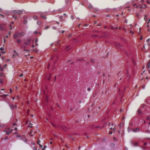
Prof. Anis
After they adjusted the data for socioeconomic status, body-mass index (BMI), hypertension, diabetes, hyperlipidemia, chronic obstructive pulmonary disease (COPD) and other clinical comorbidities using the Romano comorbidity score, the adjusted hazard ratio for developing CVD with OA was 1.23. The adjusted hazard ratio for developing the secondary outcomes was 1.42 for congestive heart failure, 1.17 for ischemic heart disease and 1.14 for stroke. These findings were similar to those in a 2013 study of 40,817 OA patients co-authored by Prof. Anis that found an almost identical stroke risk in this population.5
The mean age of patients in the Atiquazzaman study was 64.53 years, and approximately 56% were women. A higher percentage of the participants with OA were obese than those without OA. The study sample was equally distributed across different socioeconomic groups. When it came to comorbidities, hypertension and COPD were more common among people with OA than in those without OA, and people with OA had more comorbidities overall.
What is new about this study is that the findings show the mediating effect of NSAIDs on increased heart-related risks. The researchers used a novel methodology proposed by fellow epidemiologists in a 2012 paper, and they evaluated NSAIDs’ mediation of CVD risk in a survival analysis context.6 They found an association of NSAID use for approximately 41% of the increased CVD risk, 23% of the increased heart failure risk, 56% of the increased ischemic heart disease risk and 64% of the increased stroke risk in patients with OA.
Causal, Not Just Confounder
NSAIDs play a major role in increasing the risk of CVD in patients with OA.
“In epidemiological studies, a confounder is defined as a variable that is associated with the exposure and a risk factor for the study’s outcome, but does not lay in the causal pathway. Our hypothesis was that people with OA use more NSAIDs to control the symptoms of pain and inflammation compared to the general population, and that may lead them to develop CVD,” Prof. Anis says. “In other words, NSAIDs are in the casual pathway in the OA-CVD association. We adopted a mediation analysis approach to deconstruct the total effect of OA on increased risk of CVD, and we estimated how much of the total effect is explained by the NSAID use among OA patients.”
One of the strengths of this new study is its novel methodology, including marginal structural modeling in a health administrative data-based cohort, says Prof. Anis. However, it has limitations, including the fact that data on potentially important variables, such as over-the-counter NSAID use, is not included in the healthcare system’s records and was unavailable, so the mediator variable may have been underestimated. Other potentially impactful risk factors for CVD in the OA patient population, such as BMI, smoking, family history of heart disease and physical activity, are not included in the British Columbia healthcare system’s database, the researchers write.
The researchers used a strategy to impute BMI at the individual level using Canadian Community Health Survey data, but they acknowledged it still may be a confounder in this analysis. To further analyze this confounding impact, they conducted a sensitivity analysis with BMI data excluded, but they found little change in the CVD risk for people with osteoarthritis.


